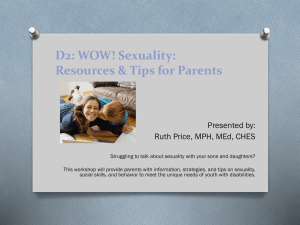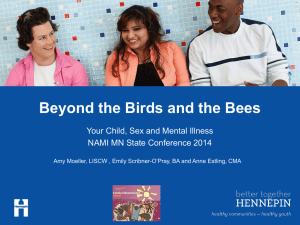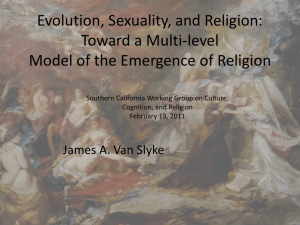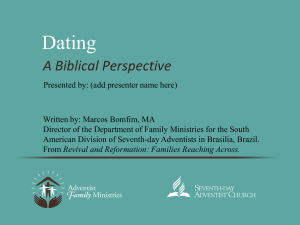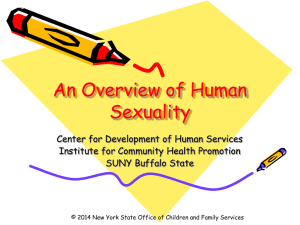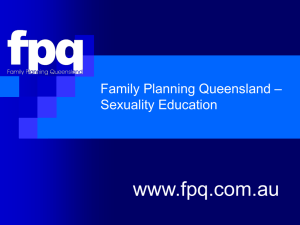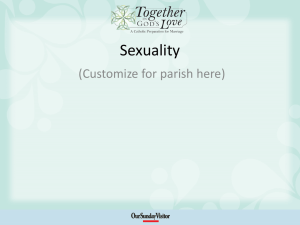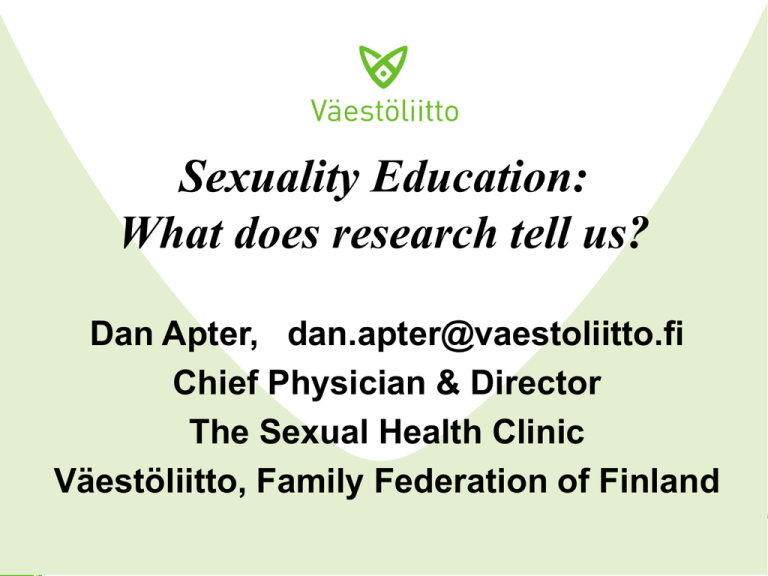
Sexuality Education:
What does research tell us?
Dan Apter, dan.apter@vaestoliitto.fi
Chief Physician & Director
The Sexual Health Clinic
Väestöliitto, Family Federation of Finland
SEXUAL HEALTH FOR
ADOLESCENTS TODAY
1. Recognizing sexual rights
2. Sexuality education and counseling
3. Confidential high quality services
Sexuality education
1. Counseling, in direct interpersonal
relationship based on recognizing individual
needs. Counseling might include very
sensitive areas.
2. Sexuality education is typically given in
schools, where a group of 20-30 young
persons of similar age listen to lectures, see
educational material and can discuss.
3. A third approach is information campaigns
about sexual health through e.g. mass media.
Sexuality education in school improves knowledge and
support informed and responsible choices
Sexuality Education – what
it is
The learning about the cognitive, emotional,
social, interactive and physical aspects of
sexuality.
Sexuality education starts early in childhood and
progresses through adolescence and adulthood.
For children and young people it aims at the
support and the protection of sexual
development.
13.4.2015
Sexuality Education II
It gradually equips and empowers children and
young people with information, skills and positive
values to understand and enjoy their sexuality, have
safe fulfilling relationships, and take responsibility for
their own and other’s sexual health and well-being.
It enables them to make choices which enhance the
quality of their lives and contributes to a
compassionate and just society.
All children and young people have the right to have
access to age appropriate sexuality education.
13.4.2015
Research and Documentation
Sexuality Education Reference Guide
• Information on
policies &
practices in
sexuality education
• Allows for
comparisons
between 26
countries
http://www.ippfen.org/en/Resources/
IPPF EN, SAFE Conference, Brussels 2007
Sexuality education
should take into
consideration love,
mutual respect and selfconfidence.
Sexuality =
essential part of human wellbeing
How good is the evidence for effect of
sexuality education on different outcomes?
Improved knowledge
Strong
Improved skills
Good
Less risk behaviour
Good
Contraceptive use
Mixed
Pregnancy reduction
Weak
STI prevention
Weak
Judith Stephenson
Margaret Pyke Professor of Sexual Health, UK
Do we have information about
the right indicators?
• Available data about sexual and reproductive
health (SRH) of adolescents:
• abortion and delivery rates, STI, contraceptive
use, sexual behavior, sexual abuse, other health
aspects, gender equality, happiness, and quality
of life? ?
• Present ways SRH services of adolescents are
provided
• Education of professionals in relation to SRH of
adolescents and children
Sex and HIV Education Programs:
Their Impact on Sexual Behaviors
of Young People Throughout the World
• Douglas B. Kirby, B.A. Laris, Lori A. Rolleri
• Journal of Adolescent Health 2007, 40: 206–217
• reviews 83 studies that measure the impact of
curriculum-based sexuality education programs
on sexual behavior and mediating factors < 25
years anywhere in the world.
Identification of evaluation studies
The program had to:
● Be a curriculum- and group-based sex or HIV
education program
The research methods had to:
● Include a reasonably strong experimental or quasiexperimental design with both intervention and
comparison groups and both pretest and posttest
data collection.
● Measure program impact upon one or more of the
following sexual behaviors: initiation of sex,
frequency of sex, or number of sexual partners; use
of condoms or contraception more generally;
composite measures of sexual risk
Sexuality education works !
• Two thirds of the programs significantly improved one or
more sexual behaviors.
• The evidence is strong that programs do not hasten or
increase sexual behavior but, instead, some programs
delay or decrease sexual behaviors. Effective curricula
incorporated 17 characteristics that describe the
curricula development; the goals, teaching strategies;
and their implementation.
• Programs were effective across a variety of countries,
cultures, and groups of youth. Replications of studies
indicate that programs remain effective when
implemented by others in different communities,
provided all the activities are implemented as intended
in similar settings.
Impact on contraceptive use
Condom use
• Of the 54 studies measuring program
impact on condom use, almost half (48%)
showed increased condom use; none found
decreased condom use.
Contraceptive use in general
• Of the 15 studies measuring impact, 6
showed increased contraceptive use, 8
showed no impact, and 1 showed
decreased contraceptive use
Sexual abstinence only programmes
to prevent HIV infection in high
income countries: systemic review
Underhill et al BMJ 2007
• 13 trials enrolling 16 000 US youths
identified, all outcomes were self reported
• No program affected incidence of unprotected
sex, number of partners, condom use, or
sexual initiation
1994:
”The Evolution of Sexual
Health in Finland:
How we did it”
2001:
”The Evolution of Sexual Health in
Finland: How we spoiled it”
2009:
How we did it again?
VÄESTÖLIITTO Dan Apter
13.4.2015
Abortions and deliveries (per 1000) in 1519 yr old girls in Finland 1975 - 2010
Sex.edu and
health services
developed
Sex.edu and
health services
were reduced
Sexuality education
developed again
8,5
National Core Curriculum
for Basic Education
the objectives and core contents of health education are
issued in accordance with lesson allocation as follows:
• Grades 1–6: health education integrated into
environmental and natural studies
• Grades 7–9: a total of three units (= 114 lessons over
3 years) as an independent health education subject.
• Sexuality education is a part of health teaching.
Sexual health core contents consist of: human
relations, sexuality, behavior, values and norms.
Sexuality education as part of health
teaching
• Sexual health: human relations, sexuality,
behavior, values and norms
• The student should learn basics of sexual health,
the importance of contraception and methods for
it, and be able to consider and justify responsible
sexual behavior
• The student should be able to name, recognize
and reveal different feelings, and describe their
development and reasons, and provide examples
how behavior and interactions can be regulated
according to the situation
Ministry of education, guidelines for teaching 2004,
but my translation
% girls who have had intercourse,
Finland 1996-2007
STAKES school health survey
40
35
30
25
20
15
10
8 grade
9 grade
5
0
96/97
99
D Apter, EntreNous p12-13, 2009
1
3
5
7
%-girls who did not use contraception at last
intercourse, Finland 1998-2007.
STAKES school health survey
25
20
15
8 grade
9 grade
10
5
0
1998
2000
2002
2004
D Apter, EntreNous p12-13, 2009
2006
2007
Abortions and deliveries per 1000 girls
15-19 year old in Finland 1975 to - 2008
%-girls who did not use
contraception at last
intercourse
Aim and structure of the
sexual health knowledge study
• Produce a representative picture of sexuality
education of school grade 7-9 in 2006, and the
changes from 1996, particularly related to the
introduction of a new subject, health, as described
by teachers
• Evaluate the sexual health knowledge of 8 grade
students by a national quiz, and changes between
2000 and 2006
• Combine the information provided by the teachers
with knowledge of the students in the same
schools, to evaluate the impact of sexuality
education
Väestöliitto 2007
Number of hours
Health knowledge is obligatory with 3
courses during grades 7-9, total 114 h.
Sexuality education hours:
1996
2006
Grade 7
2,5
5,9
Grade 8
4,3
8,7
Grade 9
7,9
6,2
Teachers
• Still various backgrounds
• Greater variety of methods is used
• Only 4% thought it was difficult to talk
about sexual matters, 80% considerded it
easy
A study of students’
sexual health knowledge
• In 2006, 462 schools returned the
questionnaires of 33 819 students (30241 in
2000) at grade 8.
• 75 questions in common in 2000 and 2006
• In 2000, mean number of correct answers
was 49,6 and 51,5 in 2006
• The number of correct answers increased
for girls from 53,9 to 55,1, and for boys from
45,4 to 48,3
Distribution of sum of knowledge
for girls and boys in 2006, %
Number of correct
answers
0-38
Girls
Boys
4,8
15,4
39-51
21,7
40,1
52-61
50,5
39,7
62-75
23,0
4,8
Extent of sexuality education in Health, school
grades, and the number of correct answers.
Boys
Extent of sexuality education
School
grades
8.5-10
Several One h
hours
54.8
49.1
Not at
all
50.3
No
health
39.9
all
7.5-8.4
51.9
47.1
47.6
42.9
50.3
6.5-7.4
48.3
43.2
45.5
39.7
46.8
< 6.5
45
40.3
39.8
37.3
42.8
all
51.1
45.6
47.2
40.4
49.3
52.9
Q41. Emerency contraception should be used:
80
80
64
60
Girls
40
20
3
8
14
10
6
2
Boys
0
1
2
3
4
1. in a week from unprotected intercource
2. in two weeks from the absence of periods
3. as soon as possible, but at the latest 72 hours from
unprotected intercource
4. at the latest six hours from unprotected intercource
Q28. Who is responsible for preventing
adolescent pregnancies and STDs?
Letter by the Archbishop of Finland 1998
• I give my support to your work in order to ensure
sexual rights for children and adolescents
throughout the world, especially in developing
countries.
• Accurate, age- and culture-appropriate
information about sexuality is a foundation
for nurturing of healthy adolescents, adults
and relationships.
• I am pleased to hear about your efforts to
address such problems as access to family
planning and proper use of contraception
methods, safe parenthood and STD/HIV
prevention programs
Conclusions
• When adolescent sexuality is not condemned but
sexuality education and sexual health services are
provided, it is possible to profoundly improve
adolescent sexual health with comparatively
small costs.
• But each year new groups of young people
mature, requiring new efforts. Education,
counseling and services are all needed. If the
resources are cut too much or not given, negative
effects are soon evident.



